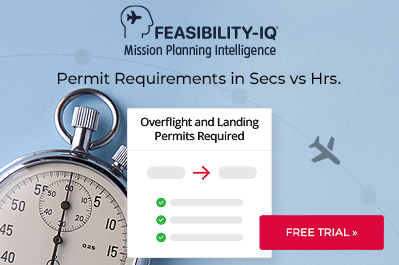Overflight Permits – Part 1: General Requirements

This business aviation blog post is part of a series on overflight permits.
Overflight permits are authorizations from Civil Aviation Authorities (CAAs) to overfly that country’s airspace. These differ in terms of regulations and airspace coverage area, depending on the country. It’s always important to check overflight permit requirements in advance with your 3rd-party provider for the planned route of flight.
The following is an overview of what you need to know:
1. Overflight permit requirements
Many countries impose overflight permit requirements, which apply to both private non-revenue and charter (non-scheduled commercial) flight activity. Over recent years more countries have been adding such requirements. Suriname and Brazil for example did not have overflight permit requirements in the past, but they both now do. For aircraft flying on experimental or non-full airworthiness certificates, overflight permits are generally required even if the country in question does not require a permit for standard General Aviation (GA) flights. Experimental aircraft generally face longer permit lead times, additional documentation, and specific aircraft operating restrictions.
2. Overflight permits are not always required
While most countries in Asia, Africa, and South America require overflight permits, for private non-revenue and charter flights, these permits are generally not required for Europe. If you’re operating an experimental aircraft, however, most European countries do require permits to overfly.
3. Permit lead time varies
Overflight permits can usually be processed within three to five business days, and this is the case for most of Asia, Africa, the Middle East, and South America. Some countries, however, require longer permit lead times. Mongolia, for example, needs 14 business days to approve an overflight permit while Togo requires 10 days, Myanmar mandates nine days, and Indonesia requires seven business days. Short-notice overflight permit requests may be possible at discretion of local CAAs.
4. Permit requirements for chosen routings
Once you determine the countries you’ll be overflying, you’ll need to research particular requirements for each country regarding permit lead times, necessary information/documentation, and Flight Information Regions (FIRs), among other concerns. It’s important to review the entire routing against flight charts to ensure you do not miss any necessary permits.
5. No-go routings
There are many instances around the world when you aren’t permitted to use a specific route or operate between two countries. Some examples are as follows:
- In most cases, you cannot operate directly between Taiwan and China, or between Argentina and the Falkland Islands.
- Israel is not available for overflight.
- If you’re operating an Israeli-built aircraft, you will not be permitted to overfly most countries in the Middle East.
- When operating between China and India, you’re pretty much restricted to the PURPA route – which may be available with sufficient advance notification. Keep in mind, however, that if China denies this request, this means adding additional time to your routing and having to revise both routes and permits.
- Venezuela CAA will not let you overfly the country if you have outstanding overflight fees, and they may not let you know this until you’re close to entering their FIR.
- Like Venezuela, Mexico DGAC will not let you enter Mexican airspace if you owe outstanding SENEAM fees. They’ll deny you access even if you have an approved flight plan filed, and they won’t notify you if they have you or your aircraft flagged for owing unpaid fees.
6. Determining routing
Aeronautical Information Publications (AIPs) normally dictate rules, including overflight permit requirements, for each country. Some AIPs, however, may be difficult to obtain or may be written in the country’s native language, with no English versions available. When you plan a trip, it’s imperative that you determine a practical route of flight. Routings based on best winds for example may set you up for airways that may be closed, one-way only, or not available to GA. It’s always necessary to create a useable routing – and not a routing that puts you over countries that may be sanctioned or prohibited for your particular flight operation due to insurance restrictions, company operational specifications, and/or lead passenger preferences.
Conclusion
When dealing with the world of overflight permits, it’s important that operators understand all requirements and restrictions. In addition to what has been covered above, also consider special request formats, documentation requirements, operating hours, potential language barriers, and urgent request/revision options.
Questions?
If you have any questions about this article, contact me at shawnleavell@univ-wea.com.
Later, we’ll discuss documentation and revision requirements for overflight permit requests.




